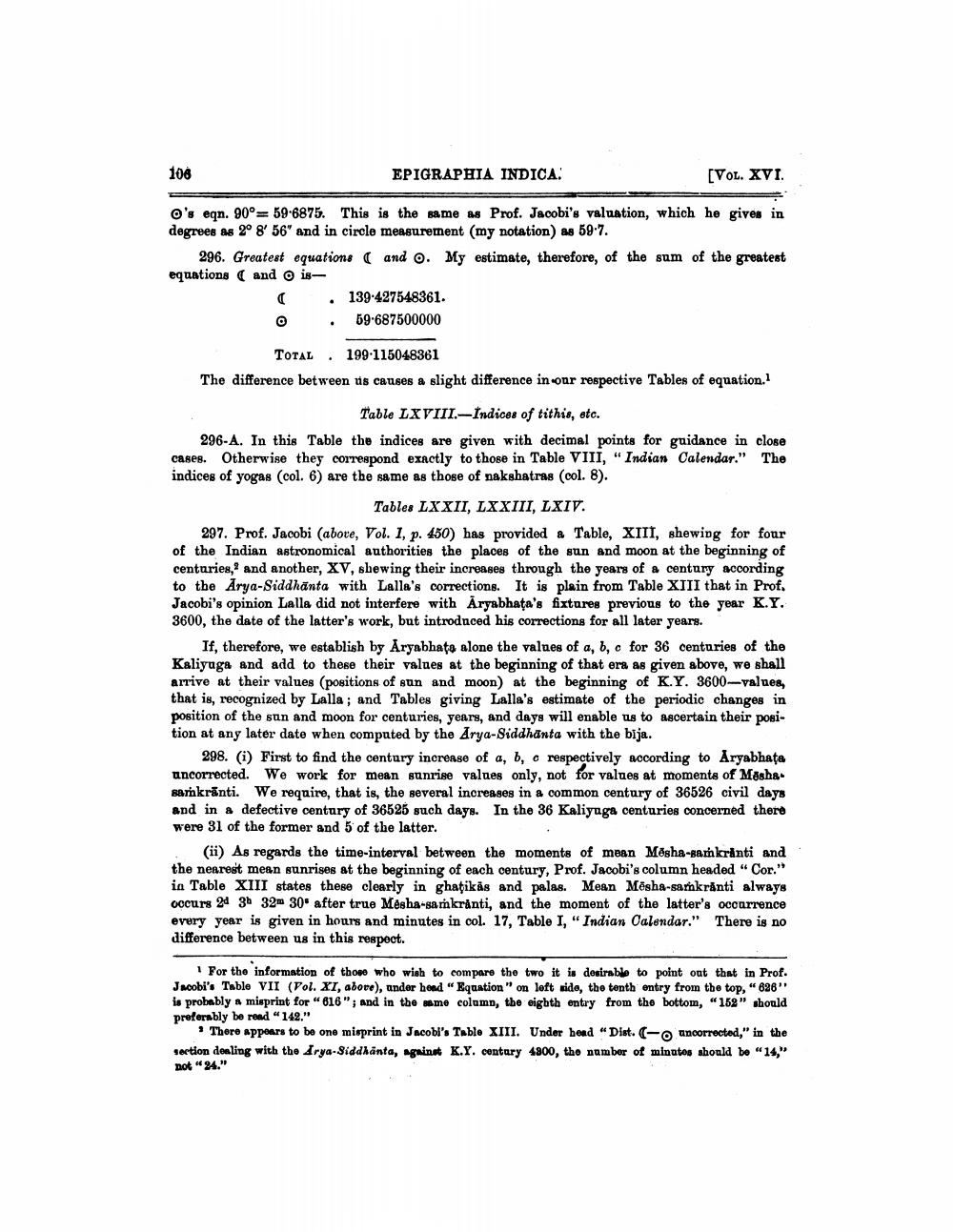________________
106
EPIGRAPHIA INDICA!
[VOL. XVI.
o's egn. 90°= 59.6875. This is the same as Prof. Jacobi's valuation, which he gives in degrees as 2° 8' 56' and in circle measurement (my notation) as 59.7.
296. Greatest equations ( and O. My estimate, therefore, of the sum of the greatest equations (and is
( 139-427548361. 0
59.687500000
TOTAL: 199·115048361 The difference between us causes a slight difference in our respective Tables of equation.1
Table LXVIII.-Indices of tithis, etc. 296-A. In this Table the indices are given with decimal points for guidance in close cases. Otherwise they correspond exactly to those in Table VIII, "Indian Calendar." The indices of yogas (col. 6) are the same as those of nakshatras (col. 8).
Tables LXXII, LXXIII, LXIV. 297. Prof. Jacobi (above, Vol. I, p. 450) has provided & Table, XIII, shewing for four of the Indian astronomical authorities the places of the sun and moon at the beginning of centuries, and another, XV, shewing their increases through the years of a century according to the Arya-Siddhānta with Lalla's corrections. It is plain from Table XIII that in Prof. Jacobi's opinion Lalla did not interfere with Aryabhata's fixtures previous to the year K.Y. 3600, the date of the latter's work, but introduced his corrections for all later years.
If, therefore, we establish by Aryabhato alone the values of a, b, c for 36 centuries of the Kaliyaga and add to these their values at the beginning of that era as given above, we shall arrive at their values (positions of sun and moon) at the beginning of K.Y. 3600-values, that is, recognized by Lalla ; and Tables giving Lalla's estimate of the periodic changes in position of the sun and moon for centuries, years, and days will enable us to ascertain their position at any later date when computed by the Arya-Siddhanta with the bija.
298. (i) First to find the century increase of a, b, c respectively according to Aryabhata ancorrected. We work for mean sunrise values only, not for values at moments of Masha samkrānti. We require, that is, the several increases in a common century of 36526 civil days and in a defective century of 36525 such days. In the 36 Kaliyuga centuries concerned there were 31 of the former and 5 of the latter.
(ii) As regards the time-interval between the moments of mean Mösha-samkrinti and the nearest mean sunrises at the beginning of each century, Prof. Jacobi's column headed " Cor." in Table XIII states these clearly in ghatikās and palas. Mean Mēsha-samkranti always occurs 20 31 32 30' after true Mesha-sankranti, and the moment of the latter's occurrence every year is given in hours and minutes in col. 17, Table I, "Indian Calendar." There is no difference between us in this respect.
1 For the information of those who wish to compare the two it is desirable to point out that in Prof. Jacobi's Table VII (Vol. XI, above), ander hend "Equation" on left side, the tenth entry from the top," 826" is probably a misprint for "616", and in the same column, the eighth entry from the bottom, "162" should preferably be read "142."
• Thore appears to be one misprint in Jacobi's Table XIII. Under head Dist. (-o ancorrected," in the sertion dealing with the Arya-Siddhanta, against K.Y. centary 4800, the number of minutes should be " 14," not " 24."




